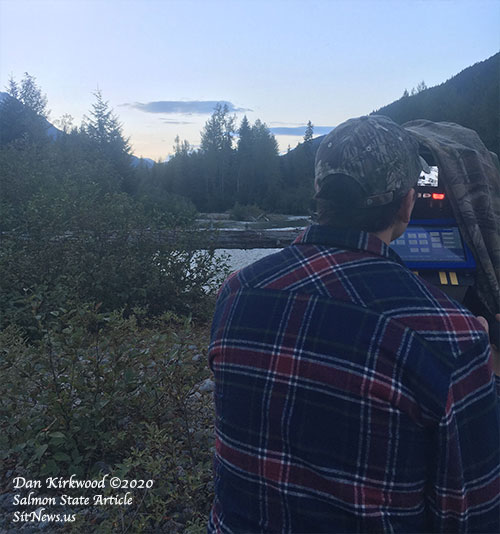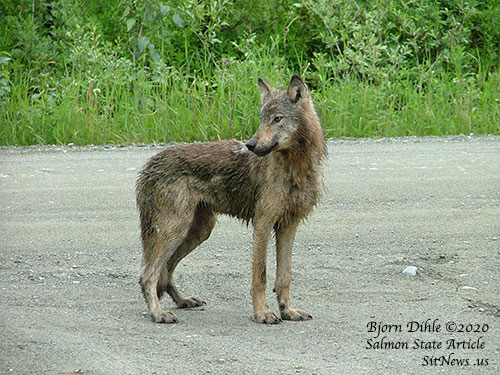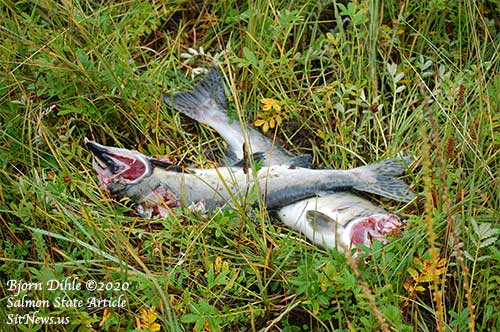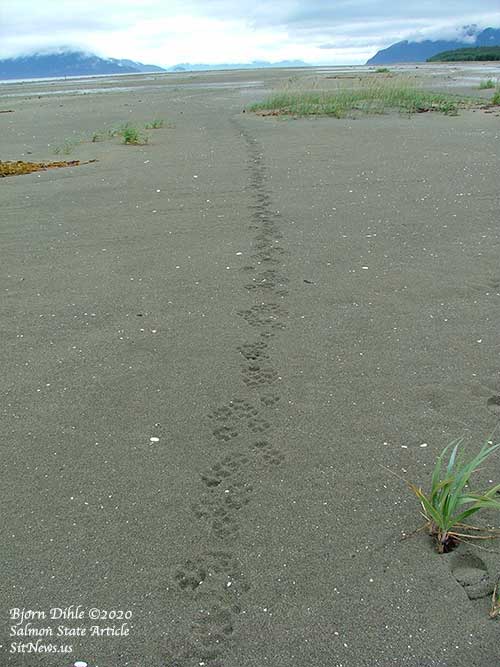
The Salmon StateThe salmon-eating wolves of Alaska: Tongass film shoot captures, for the first time on video, wolves catching salmon at nightBy MARY CATHARINE MARTIN
February 19, 2020
They were next to a salmon stream in the Tongass National Forest, wearing night vision goggles and filming with thermal imaging cameras, attempting to capture something that hadn’t yet been previously captured on film: wolves catching salmon at night.
Back in Juneau, I was waiting to hear from them, because this is a personal story, too: the lead guide, Bjorn Dihle, is my partner. He’d been excited to scout out locations for wolves, but was also measured in his optimism about their chance of success. No matter how hungry a wolf is for a salmon, they’re generally exceptionally wary of humans. Dan Kirkwood is the manager at Pack Creek Bear Tours, where Bjorn works. When Dan first got the call inquiring about the possibility of a night shoot, he was hiking down from a Southeast Alaska mountain, checking a camera trap he’d set up for wolves. At first he thought, “This is impossible. The odds are just insanely long.” But they agreed to try, and Bjorn headed down early to scout the area they’d chosen. “I didn’t know where or if I would find the right spot, so I scouted the majority of the watershed as far as the salmon were spawning,” Bjorn told me. “Because it was also on a stream with brown bears, I was looking for an area that was relatively open, so that we could mitigate bear encounters by having some time to communicate with them.”
Eventually, he came across a spot that seemed pretty promising: he not only saw a wolf there, he saw wolf tracks, wolf scat, wolf beds, and 50 or 60 salmon with their heads removed. (Wolves are more sensitive than bears to parasites that can live in the rest of the salmon.) All of that was no guarantee, however, that the wolves would emerge when the team of three was there. When dark fell, the alpha male and the alpha female showed themselves at dusk about 100 yards away. When they saw the three men, the wolves retreated. “And then as soon as it got dark, the wolves came out and felt comfortable coming within 10, 15 yards of us because they believed we couldn’t see them,” Bjorn said. “Without the goggles, you would have said ‘Oh, there was a bird there.’ They’re so quiet — you wouldn’t have known.” “You can see the animals like they’re lit up with the night goggles, because they’re just glowing against nothing,” Dan said. “Without them, you can’t see anything. The trickle of the stream, the finning of the fish as they’re swimming upstream, and pretty constant wolf howling all night… it was very surreal, because I was seeing it through a screen the whole time, with the exception of the wolves that came out at dusk and in the morning.”
The next morning, as they were hiking out, a small female wolf trailed them. “I was really surprised at how some of the wolves decided to really not be too bothered by us,” Dan said. As a guide, Bjorn pointed to the growing importance of experiences like this, and films like this, to Alaska’s economy. Bears also feature in the filming. “Wildlife and wild places are going to be a way bigger resource in the future as the world becomes more industrialized, and I think we need to have way more of an emphasis on preserving these wild places,” he said. “It’s ridiculous that Southeast Alaska only has a couple of bear-viewing places. That’s why people come here. It’s huge, whether it’s hunting, fishing, wildlife films or just tourism.” Salmon, he said, were also central to the shoot. “The only reason why we were able to get the footage we were and be safe around bears is because we had such a good salmon run,” Bjorn said. “It’s all about salmon.”
How Alaska wolves rely on salmon It’s not a secret that, in Alaska, wolves rely on salmon, just as many other species do. It is, however, a subject of evolving research. Back in 2004, Alaska Department of Fish & Game Information Officer Riley Woodford wrote about a study on Prince of Wales Island in an Alaska Fish & Wildlife News article. Salmon, the article explained, are especially important for wolf pups. “For the youngest members of the packs, the chance to fatten up on fish in the fall can mean life or death over the winter,” it reads. The biologist who conducted that study, Dave Person, attributed wolves’ high survivorship in Southeast Alaska to salmon. “In places like Minnesota, half the pups die in their first summer,” he’s quoted as saying. “Here, we’ve noticed a 90 percent survivorship; I think salmon may play an important part in that.” Alaska Department of Fish & Game wildlife research biologist Gretchen Roffler is conducting a study using DNA to analyze wolf scat across Southeast Alaska. Wolves ate salmon in five of the 12 sites she studied, making up between two and 10 percent of wolves’ diets overall, averaged across the entire year, between 2010 and 2018. The numbers would be much higher, she expects, in late summer. “Increased consumption of (marine and intertidal species) could be advantageous for wolves because of reduced handling times and risk, allowing wolves to forage individually. Salmon are well-recognized as an important seasonal food source for wolves in coastal regions,” she said. Of a separate study of collared wolves, she wrote that a wolf they’re observing in the Gustavus, Alaska area spent many weeks fishing in late August to mid-September, eating pink and sockeye salmon. An earlier study in Woodford’s article analyzing DNA in wolf bone found that “Salmon made up about 20 percent of the diet of wolves on the coastal mainland and on Prince of Wales Island, 15 percent of the diet of wolves on Kupreanof Island and about 10 percent of the diet of Interior wolves.” How to watch “Night on Earth” is streaming on Netflix. This shoot is part of the last episode in the series, at minute 35.
Representations of fact and opinions in comments posted are solely those of the individual posters and do not represent the opinions of Sitnews.
|
|||||||



